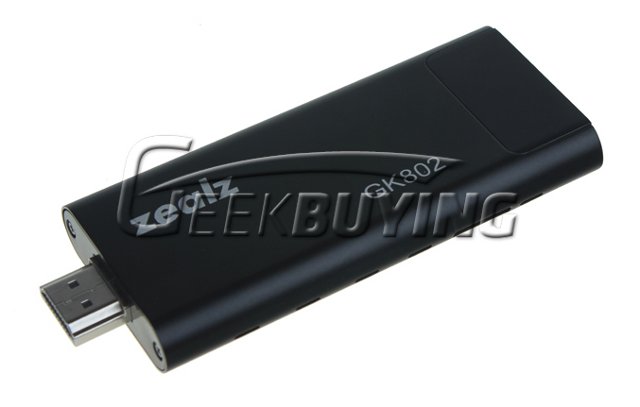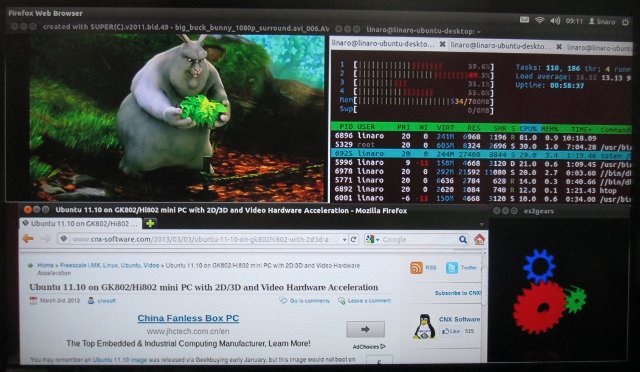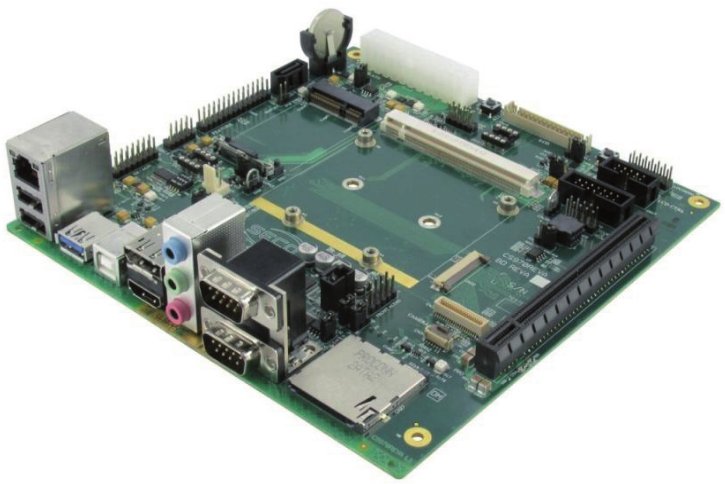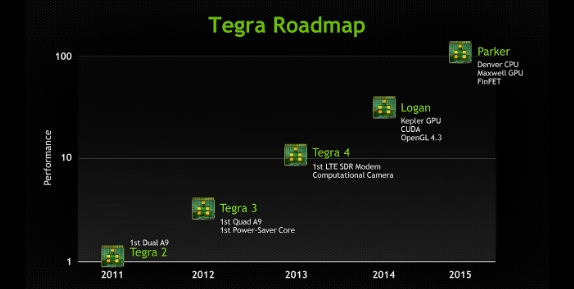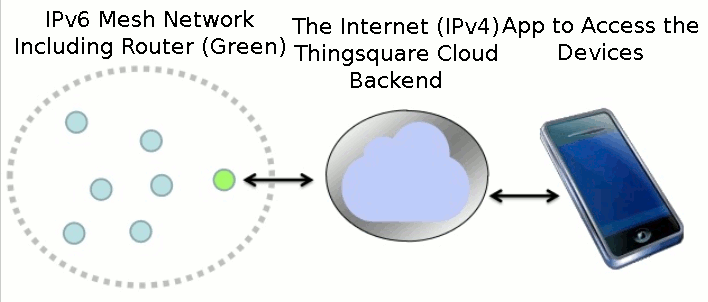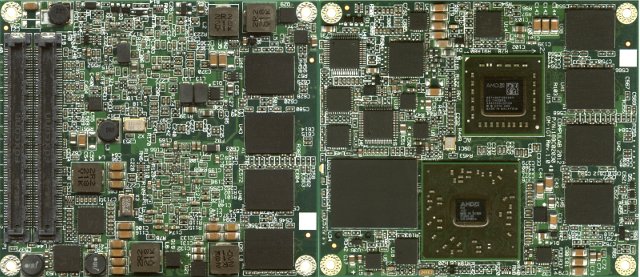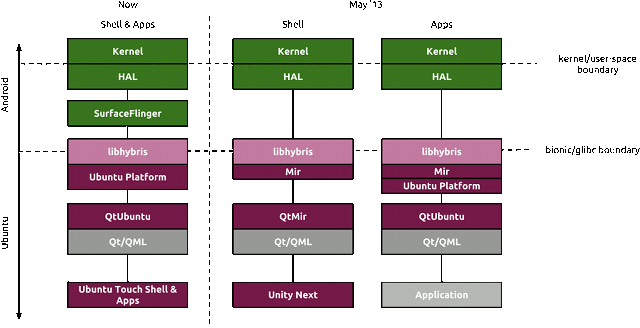Zealz GK802 is a mini PC based on Freescale i.MX6 Quad processor, with 1GB RAM, 8 to 16 GB internal memory (internal micro SD card). The main selling points of this HDMI dongle is that it’s the only currently available quad core processor (about to change), it’s hackable and unbrickable with easy access to the serial console, full support for Linux with hardware video decoding and 2D/3D acceleration (work in progress), and Freescale has released proper software and hardware development resources for the i.MX6 processor. As mentioned in my review of Hi802 mini PC, the downside is that Vivante GC2000 GPU performance is lower than the Mali-400 MP4 found in Rockchip RK3066 mini PC, and its price (usually above $90) is about double the price of Rockchip RK3066 mini PCs. We can’t do anything for Vivante GC2000 performance, but Roman found a coupon code “FVKIWVAG” on a Russian forum that […]
Ubuntu 11.10 Image for Hi802 / GK802 is Now Available for Download
About 2 weeks ago, Jasbir released an Ubuntu 11.10 image and installation instructions for GK802 and Hi802 mini PCs based on Freescale i.MX6. I could only find time to give it try yesterday and today. I’ll provide the steps I followed to install the image, and my quick first impressions of the stability and performance of this image. Installation Instructions I mainly followed the instructions provided by Jasbir, and run GParted to increased the partition size on my micro SD card. The image is for a 8 GB micro SD, but those instructions should work on 4GB SD card and greater, as the rootfs partition is only 3GB large. Download the Ubuntu 11.10 image, uboot, as well as the kernel image and modules in a Linux PC:
|
1 2 3 4 |
wget http://dl.miniand.com/jas-hacks/gk802/ubuntu_gk802.img.gz wget http://dl.miniand.com/jas-hacks/gk802/u-boot.imx wget http://dl.miniand.com/jas-hacks/gk802/uImage_3.0.35-0269_cpu_freq wget http://dl.miniand.com/jas-hacks/gk802/modules_3.0.35-02695.tar |
Copy the image, uboot and the kernel to the micro SD card by typing the commands below:
|
1 2 3 4 |
gzip -d ubuntu_gk802.img.gz sudo dd if=ubuntu_gk802.img of=/dev/<sd_device> sudo dd if=u-boot.imx bs=1k seek=1 of=/dev/<sd_device> && sync sudo dd if=uImage_3.0.35-0269_cpu_freq of=/dev/<sd_drive> bs=1048576 seek=1 && sudo sync |
Replace /dev/<sd_device> by your […]
SECO mITX GPU DevKit Features Nvidia Tegra 3, Supports CUDA 5
SECO mITX GPU DEVKIT is a GPU computing development kit that provides a Mini-ITX Qseven 2.0 carrier board (SECO mITX Carrier Board) with a Nvidia Tegra 3 powered Qseven SoM (QuadMo747-X/T30). The carrier board provides a PCI-e x16 connector (PCI Express x4) intended to allow the connection of CUDA 5 enabled desktop graphics boards. Embedded Control Europe reports that the platform will support Nvidia Kayla platform. The main specifications of the platform are as follows: CPU – Nvidia Tegra 3 Quad-Core ARM Cortex A9 GPU – TBD. But you should be able to insert Nvidia graphics card via the PCI-e x16 connector (PCI Express x4) on the mini-ITX board Memory – 2 GB Storage – 4 GB eMMC + 1x SATA 2.0 Connector Network – 1x Gigabit Ethernet USB – 3x USB 2.0 + 1 OTG port Display – HDMI The platform will support Linux Ubuntu , as well as […]
Nvidia Updates its Tegra Roadmap with Parker 64-Bit ARM SoC, Unveils Kayla CUDA Development Platform
Nvidia has given an update about the roadmap for its Tegra processor at the GPU Technology Conference in San Jose, California. Tegra 4 will still be followed by Logan (Tegra 5) as planned with a Kepler GPU and support for CUDA and OpenGL 4.3, but “Stark” has been replaced by “Parker” (Tegra 6) which will be the first 64-Bit Tegra processor based on Denver CPU, Maxwell GPU and make use of Finfet transistors. Logan will be available in 2014, and Parker should be available in 2015 with 100 times more performance than Tegra 2. With this kind of performance, the separation line between desktop and mobile processors will be gone. Nvidia also unveiled Kayla (“Logan’s girlfriend”), a development platform for CUDA and OpenGL based on Tegra 3 quad-core ARM processor and a Kepler GPU connected via a PCI express slot. Jen-Hsun Huang (above) showcased Kayla performance by running real-time ray […]
Thingsquare Mist – Open Source Firmware for The Internet of Things
Thingsquare recently released the source code for the Thingsquare Mist firmware, an ultra lightweight router software (<4 kB memory) for the Internet of Things based on open Internet standards such as IPv6, RPL (Routing Protocol for Lossy networks), and 6lowpan. Thingsquare Mist allows to connect battery-powered wireless micro-controllers to the Internet, and is currently used in applications such as smart light bulbs, connected home appliances, and connected cities. The IPv6 mesh network is composted of nodes with a low power radio that communicate with the Mist router (Green), which in turn connect to the Internet and Thingsquare Cloud backend (Thingsquare Haven) to store the data, and/or receive control commands via Ethernet or Wi-Fi. The end users can then use an App to monitor, and/or control the devices remotely. Thingsquare Mist uses IETF RPL IPv6 mesh routing protocol (pronounced “ripple”) for IPv6 nodes communications. Thingsquare Mist runs on several low-power wireless […]
ARMBRIX Zero / OPENBRIX Zero Board Cancelled
ARMBRIX Zero (renamed to OPENBRIX Zero), the cheapest ARM Cortex A15 board that was supposed to hit the market next month, won’t be produced anymore. Howchip has published a laconic notice to explain the cancellation: Dear Customers Due to a situation experienced by the ARMBRIX Company(www.armbrix.com), the production of its boards have been discontinued. At this time we ask for the understanding of our customers who have shared interest in the ARMBRIX zero/OPENBRIX zero product. Every PAYPAL payment will be refunded by next week. Refunds will take 3-5 business days to process. We apologize for this inconvenience, and would like to thank every customer that has appreciated the ARMBRIX/OPENBRIX zero product. The project owner cannot provide an explanation why this has been canceled (it’s probably confidential), but still offer people to contact him if they have project ideas for the board. That means the only Cortex A15 option is now […]
$89 Compulab CM-iGT CoMs Feature AMD G-Series APUs
Compulab, an Israeli company specialized in embedded computing, has recently introduced computers-on-module based on AMD G-Series APUs that will sell for as low as $89 per unit (for 1k orders) depending on selected features and options. The module is available in commercial, extended and industrial grades, and supports up to 4GB RAM, and 32 GB Flash. Here are the specifications of these modules: CPU – AMD G-Series Processor: G-T16R single-core @ 600MHz, G-T40E dual-core @ 1GHz or G-T56N dual-core @ 1.65GHz GPU – Integrated GPU Radeon HD 6250 supporting the following standards: DirectX 11, OpenGL 4.0, OpenCL Video Processing Unit – UVD 3 engine with native H.264, VC-1, MPEG2, and DivX, 1080p Blu-Ray playback support System Memory – 2GB – 4GB DDR3-1066, 64-bit Storage: On-board BIOS flash, 1MB, reprogrammable On-board SSD, up to 32GB, MLC, through SATA interface Interfaces: Display – Up to two DisplayPort interfaces, up to two HDMI […]
Future Versions of Ubuntu To Feature Mir Display Server Compatible With Android Graphics Drivers
The X server is getting old, and many developers complain it’s not an optimal solution anymore due to its (over) complexity, which was why Wayland was developed. However, it turns out Ubuntu will not use Wayland, but instead their own display server called Mir which will be used in all form factors from phones to desktops. Phoronix has provided a quick summary about the key aspects of Mir: Mir is a new display server being developed at Canonical and it is not based on X.Org or Wayland. Android graphics drivers will be supported. Existing DRM/KMS/Mesa/GBM (the open-source Linux graphics drivers) will work. Canonical is pressuring the binary blob vendors to make their drivers compatible. There will be support for legacy X11 applications through an integrated root-less X.Org Server. Canonical will natively support GTK3 and Qt/QML toolkits with Mir. Mir will be used for all form factors from Ubuntu Phones to […]


